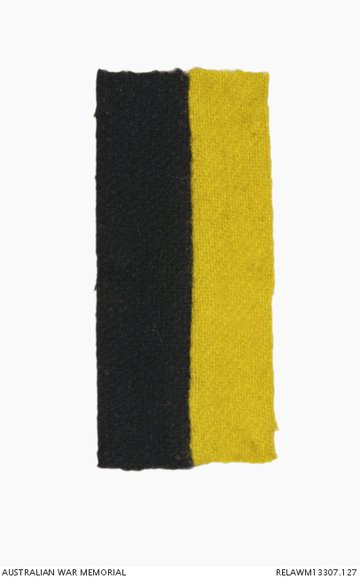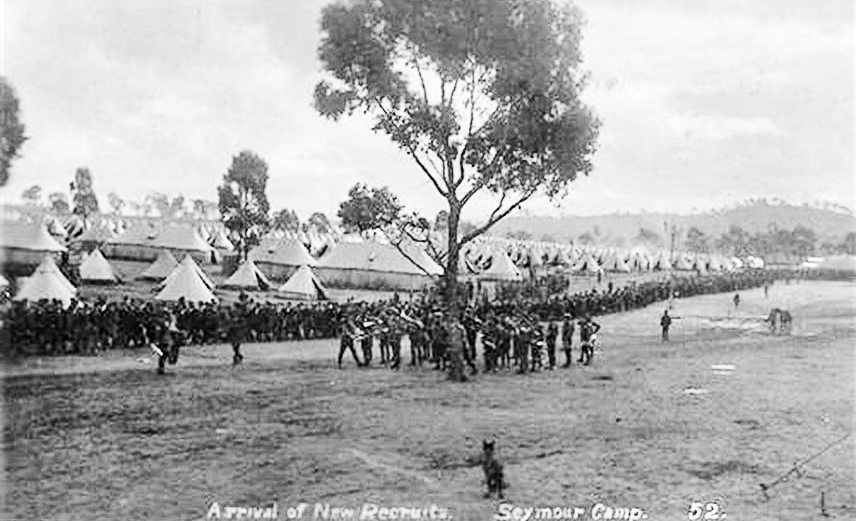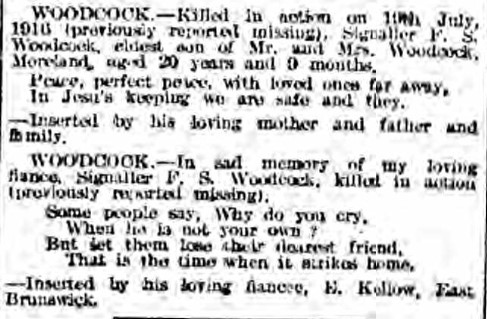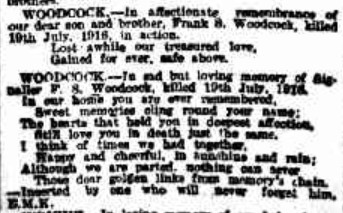Francis Stringer WOODCOCK
Eyes blue, Hair dark brown, Complexion sallow
Francis Woodcock - “Short and Fair and Full of Life”
Can you help us identify Frank?
Frank was killed in Action at Fromelles. As part of the 29th Battalion he was positioned near where the Germans collected soldiers who were later buried at Pheasant Wood. There is a chance he might be identified, but we need help. We are still searching for suitable family DNA donors.
In 2008 a mass grave was found at Fromelles, a grave the Germans dug for 250 (Australian) bodies they recovered after the battle.
If you know anything of contacts here in Australia or his relatives from England, please contact the Fromelles Association.
See the DNA box at the end of the story for what we do know about his family.
Missing, but Could Frank Still be Found?
Frank Woodcock was killed in the battle of Fromelles and his body was not identified. However, even over 100 years later there still is a chance.
Based on the reports of his death, it seems that Frank had been killed as the 29th Battalion were retreating on 20 July. If so, he was probably close to the Australian lines and his body might have been recovered.
A report by Corporal Webster provided long after the battle describes, in some detail, where and when Frank and eight other soldiers may have been buried.
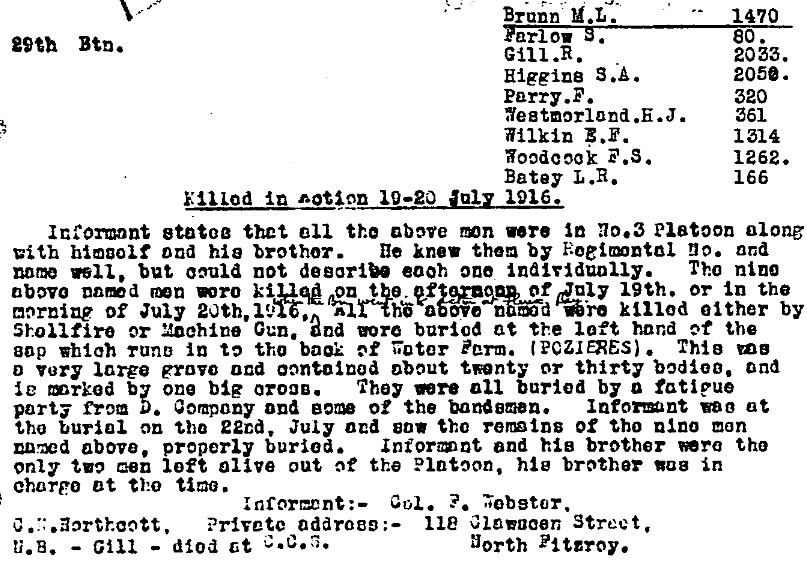
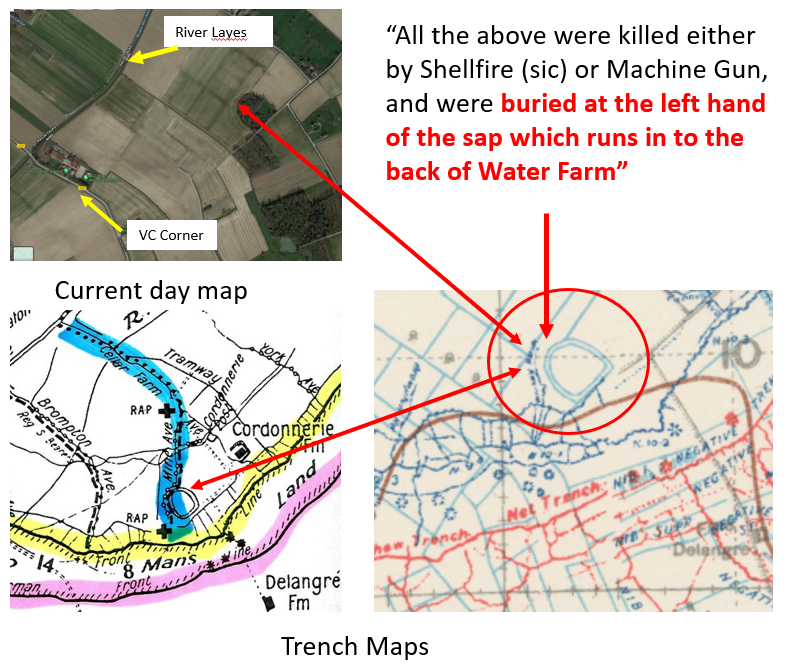
The sap (a short covered trench / tunnel) is probably on the Mine Ave end of the trench (marked in blue in the map below) near where the “water farm” is marked.
There are also similar notes in these soldiers’ AIF files that they are buried at Fleurbaix, and a general map reference, sheet 36, with the exception being Private Robert Gill who died at the casualty clearing station and is buried at the Bailleul Communal Cemetery Extension.
It would have been chaos in the trenches during the battle and in the immediate aftermath, and it is no wonder records of deaths and burials are often non-existent or contradictory. There are no records of these soldiers being found in this vicinity.
However, in 2008 a burial ground was located at Pheasant Wood behind the old German front line at Fromelles that contained the bodies of 250 British and Australian soldiers. Many of their identities, were confirmed through a combination of anthropological, archaeological, historical and DNA techniques.
To date (2024), DNA testing has been able to identify 180 of these 250 soldiers.
Despite being identified as being buried in the sap, four of these nine men - Ernest Wilkin, Frederick Parry, Samuel Farlow and Norman Brumm – were identified in 2010 as being buried in the Pheasant Wood Cemetery, some 2 km away! Was the original grave disturbed by shelling or otherwise re-opened necessitating re-burial by the Germans?
With four already identified, are the remaining four (Herbert Westmoreland, Francis Woodcock, Lemuel Batey and James Higgins) still amongst those soldiers now buried at the Pheasant Wood cemetery but unidentified?
We need to find Frank’s family members who could provide the DNA required to finally find Frank.
Frank’s Story
Francis Stringer “Frank” Woodcock was born in 1895 in Normanton, Yorkshire, England to Sam and Mary Woodcock. They had six children:
- Walter (1891-1897)
- Ada (1893–1989)
- Frank (1895–1916)
- Norah (1897–1988)
- Frederick (1900–1985)
- and John, born William Alexander (1904–1980).
As Frank was growing up, the family stayed local to the area and lived in Rotherham and Barnsley. But, in 1913, at the age of 17, his family migrated to Australia, settling in West Coburg (Melbourne). Frank’s father Sam was a watchmaker and began working for Dunklings the Jewellers. Frank listed his occupation as a watchmaker on his attestation papers and no doubt worked with his father.
Mary and Sam were well settled into Australian life and were active in their local community. They eventually built a five-bedroom home at 295 Moreland Road, West Coburg. Samuel would go on to own his own watchmaking and repair business in the city at the corner of Little Collins and Elizabeth Street, handing it down to his son John. Mary became involved in the West Coburg Progress Association.

Mary Woodcock, front row third from right
Prior to enlisting, Frank became engaged to Edith Maud Kellow, a local girl from East Brunswick, but they did not marry before he left. She entered memorial notices for Frank for a number of years after his death. She eventually married in 1927 and had three children.
Frank Heads to War
Frank was initially rejected when he tried to enlist due to “deficient height”, he was 5’ 4 ½” tall. He also had a large scar on his body that may have been the result of surgery or an accident. The minimum requirements to enlist were changed in June 1915 and Frank successfully joined on 8 July 1915. He was assigned to the 29th Battalion and did his training in the Seymour and Broadmeadows Camps. He was assigned to be a signaller, responsible for ensuring communications were able to be made across the battlefield. Signallers had to be proficient in Morse code signaling on flag, lamp and heliograph and proficient at map reading. As needed, they would run the messages to and from the front lines.
Before departing for Egypt on 10 November 1915 on the A11 Ascanius, , the soldiers had been on parade in Melbourne in front of a good crowd. The Minister for Defence, H.F. Pearce reviewed the troops and said:
“I do not think I have ever seen a finer body of men.”
After a month’s voyage, they arrived in Suez, Egypt on 7 December. His time in Egypt included further training and defence of the Suez Canal with postings at Ismailia, Tel el Kebir, Ferry Post and Moascar. The troops were reviewed by the Prince of Wales while in Tel el Kebir.
The Western Front
The call to the Western Front came and on 16 June the 29th boarded the troopship Tunisian in Alexandria, headed to Marseilles and arriving there on the 23rd. The soldiers were then taken by train from the southernmost part of France to the north to Hazebrouck. They went on to Steenbeque and by the 26th were encamped in Morbeque, about 30 km from Fleurbaix.
The Aussies were well received by the French. In a letter home, James Lang (858), 29th Battalion from Glengarry, Victoria, wrote:
“The French people lined the streets to see us, and gave us a great welcome. Lots of poor women and young girls started crying. No doubt the poor things were thinking of their own dear ones who had gone to the front.”
On 1 July the 29th moved back to Hazebrouck. Gas masks were now included in their training for the possible use of “lachrymatory shells” – tear gas. Training was tough and rugged. One day included a march of 16 miles carrying a 75 lb kit, which only the youngest and fittest could complete. On July 9th they then moved to Erquingham, just outside of Fleurbaix and on the 10th they got their first experience in the front-line trenches. They were back at their billets in Fleurbaix on the 14th. A gas alarm was sounded on the 15th, but there was no effect on the troops in Fleurbaix.
The Battle of Fromelles
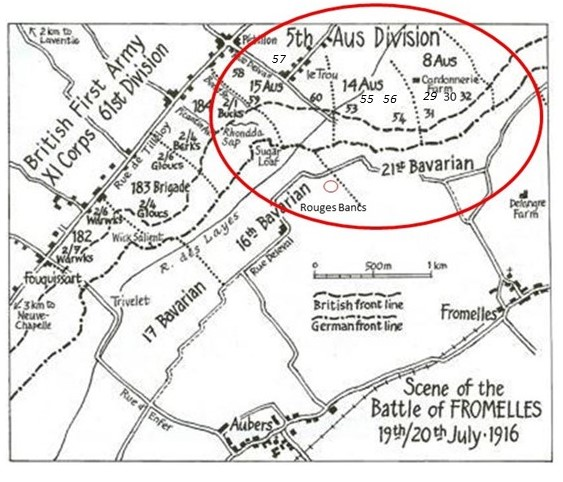
The 29th’s role was to be a ‘fourth’ battalion on the left flank of the attack. With the 30th, they were to provide support for the attacking 31st and 32nd Battalions by digging trenches, carrying supplies/ammunition and to be called in as reserves if needed for the fighting. The original attack was planned for 17 July, but bad weather caused it to be postponed.
On 19 July the 29th were in the rear trenches, poised for the attack. The 32nd’s charge over the parapet began at 5:53 PM and the 31st’s at 5:58 PM. There were machine guns emplacements to their left and directly ahead at Delrangre Farm and there was heavy artillery fire in No-Man’s-Land. The initial assaults were successful and by 6:30 PM the Aussies were in control of the German’s 1st line system, which was described as
“practically a ditch with from 1 to 2 feet of mud and slush at the bottom”. Source AWM4 23/49/12, 32nd Battalion War Diaries, July 1916, page 11
By 8:00 PM, Frank’s D Company and A Company began to carry bombs and supplies to the front trenches, so they were now well engaged in the battle. While Signaller Frank was not directly “fighting”, being a signaller was dangerous work. They were exposed to the same danger from enemy snipers and artillery when they delivered messages manually and/or running and repairing telephone lines. Manual signalling was vital when the army moved too quickly to establish a telephone network and they had to personally run the messages to and from the trenches. As the battle wore on, the Australians’ left flank had come under heavy bombardment with high explosives and shrapnel.
Return bombardment support was provided and the soldiers of the 32nd were told:
“the trenches were to be held at all costs”.
At 10:00 PM, additional support was being requested and C and D Companies joined in. Unfortunately, they found that a number of the grenades they were carrying had no fuses. The Germans counter attacked and at 2:00 AM and Frank’s D Company was further drawn into the fighting. B and C Companies were also engaged, continuing to carry supplies and providing cover for soldiers who were retiring from the battle. At 4:00 AM the Germans began an attack from the Australian’s left flank, bombing and advancing into the Australian’s communications trench. Given the Australian advances that had been made earlier, portions of the rearward trench had been left almost empty, which enabled the Germans to be in a position to surround the advanced soldiers.
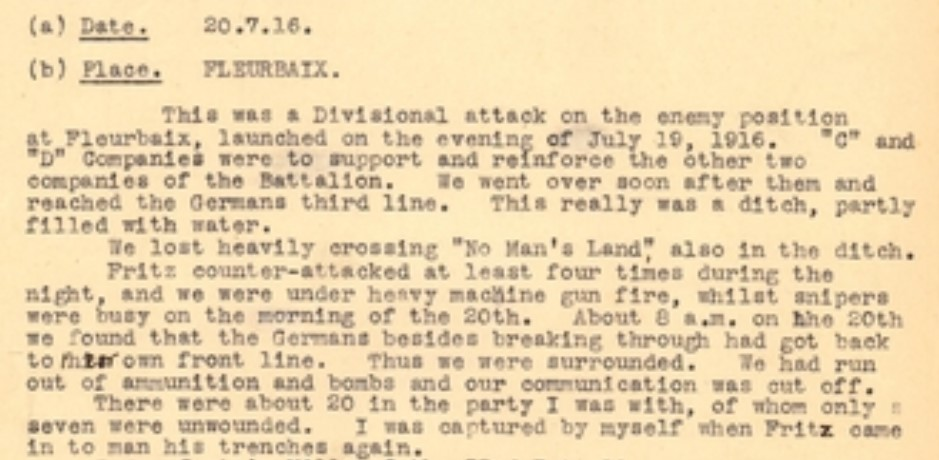
As the Australian attack had been halted, they became exposed in a salient jutting into the German lines and were quickly enfiladed by German machine guns:
In the end, they basically had to fight their way back to their own lines, run for it', or be killed wounded or captured
According to Private Alexander Cameron (1092), Frank had managed to survive through most of the night’s fighting, but had been killed by shell fire after the orders to pull back were issued (around 4 AM).

The soldiers from the 8th Brigade who could make it back began to reach their own trenches around 4:30 AM. In the morning the battle was over. The 29th were left to hold the front line and, even though a cease fire was not in effect, they were busily bringing back a large number of wounded during the day and night. The nature of this battle was summed up by Private Jim Cleworth (784) from the 29th:
"The novelty of being a soldier wore off in about five seconds, it was like a bloody butcher's shop".
When bombardment ceased on the morning of the 20th, the 29th were left to hold the front line and, even though a cease fire was not in effect, they were busily bringing back a large number of wounded during the day and night. For a battalion supposed to be in a support role, the initial figures of the impact of the battle on the 29th was 17 soldiers died, 161 were wounded and 68 were missing. Ultimately, 66 soldiers of the 29th Battalion were killed in action or died of wounds from the battle, 37 of which were unidentified. as of 2024, 22 of these soldiers have been later found to be in the German grave at Pheasant Wood.
Frank?
Frank’s friend Signaller Reginald Edmunds Evans (1104), another lad from England, was not with him at the end of the battle, but he was clearly close to Frank and described him as “short and fair, full of life”.
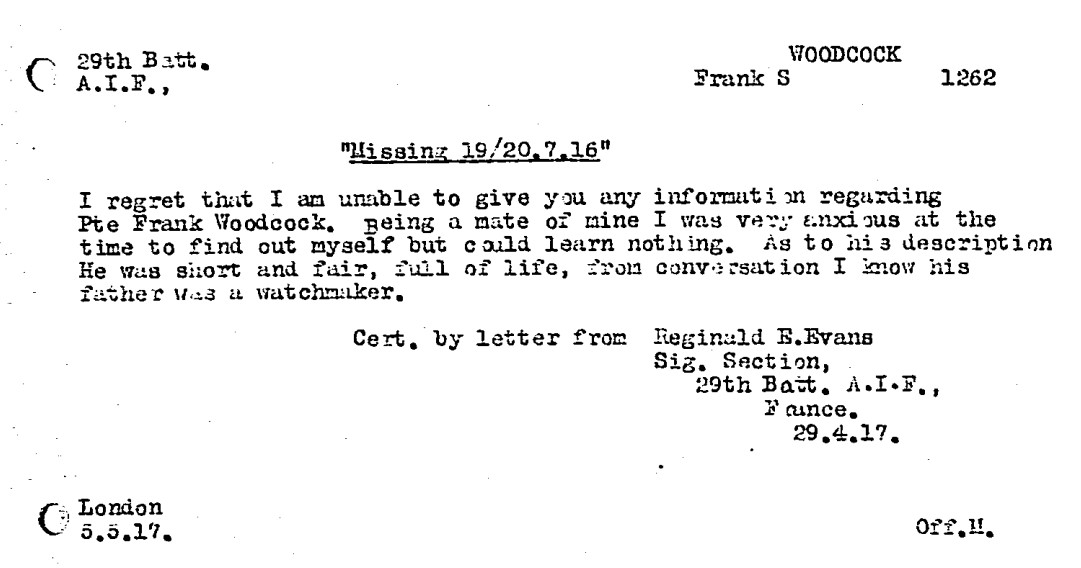
Several other of Frank’s mates reported him as being killed by a shell, but he was also reported by others as having been taken prisoner by Alfred Woodcock of the 51st Battalion, a prisoner of war in Germany. There were no records of Frank in the German files, however. Vera Deakin of the Red Cross Enquiry Bureau writing in 1917, summed it up best as:
” He has never appeared on any lists of prisoners that we received from Germany and we believe that the two men who stated they thought he was a prisoner were confusing him with another Woodcock. … We find it increasingly difficult to obtain reliable information of event which happened a year ago and we fear there is now little likelihood of any further details being received”
Frank was initially listed as missing and in 1917, a Court of Enquiry, held in the field, 23 August 1917, pronounced Frank’s fate as 'killed in action, 20 July 1916'.
Frank was remembered by his family and his fiancée.
In our home you are ever remembered
Sweet memories cling round your name;
The hearts that held yon to deepest affection.
Still love you in death just the same.
I think of times we had together,
Happy and cheerful, in sunshine and rain:
Although we are parted nothing can sever
Those dear golden links from memory's chain.
Frank was awarded the 1914-15 Star, Victory and British War Medals and is remembered with honour and commemorated at the following:
- VC Corner Cemetery and Memorial, Fromelles, France Panel 1
- Australian War Memorial Roll of Honour
- Coburg Town Hall Memorial
- Coburg Avenues of Trees, Tree 162
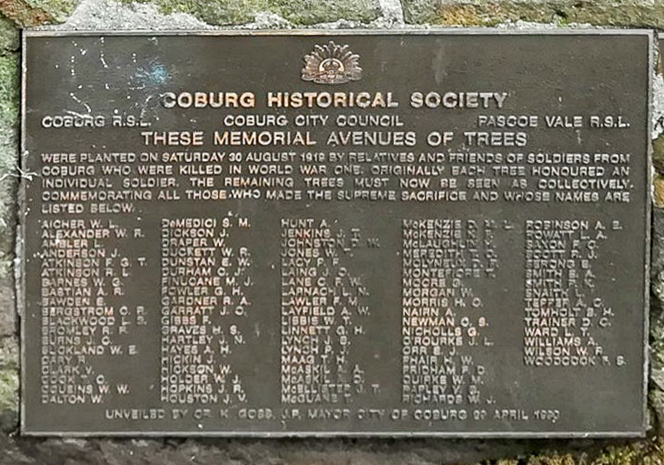
Source:
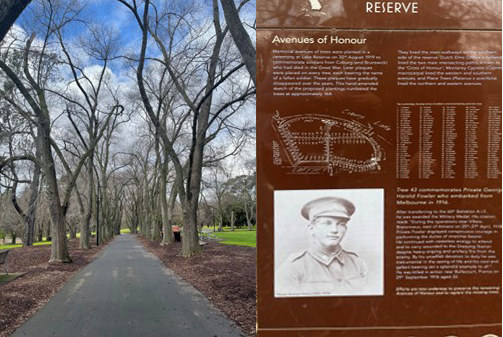
DNA samples are being sought for family connections to
| Soldier | Francis Stringer Woodcock (1895-1916) |
| Parents | Samuel Woodcock (1868-1935) Born Wakefield, England, Died Coburg, Victoria and Mary Stringer (1870-1952) Born Crigglestone, Yorkshire, England, Died Coburg, Victoria |
| Siblings | Walter (1891-1897) d Normanton, England | ||
| Ada (1893–1989) b, Normanton, England | |||
| Norah (1897–1988) d Rosebud, Victoria, married Owen Logan | |||
| Frederick (1900–1985) b Barnsley, England | |||
| John, born William Alexander (1904–1980) d Dromana, Victoria Married Lucy Sarvaas (1904-1976) d Rosebud Victoria |
| Grandparents | ||||
| Paternal | Samuel Woodcock (1830-1893) and Ann Leuty (1836-1899) from Wakefield, Yorkshire | |||
| Maternal | Francis Stringer (1830-1899) and Ann Crossley (1832-1908 | from Dirtcar, Crigglesworth, Yorkshire |
Seeking DNA Donors

Contacts
(Contact: royce@fromelles.info or geoffrey@fromelles.info).
(Contact: army.uwc@defence.gov.au or phone 1800 019 090).
Donations
If you are able, please contribute to the upkeep of this resource.
(Contact: bill@fromelles.info ).
